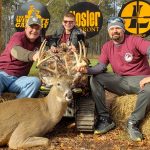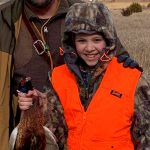Idaho Waterfowl a Fun Hunt!
by Ed H. Edwards, SCI Lansing Chapter Member, avid hunter, and fisherman
SCI Members from Five States Travel to Idaho and Have a Blast!
Take them! Four Giant Canada geese settle into our decoy spread like crows coming to fresh roadkill. Pete Shores from Florida and Dewey Mctee from Texas each drop one from the right side of the pit blind we occupied filling their limits. The two remaining make a left turn and I waste no time making a double completing my limit. Jeff Sever from Florida had already limited out and gave us high fives as considerable feathers drifted across the field. Our four-man limit of 16 geese down in about 45 minutes, a great start to our three-day hunt!
When you think of great waterfowl hunting states Arkansas, Texas, Maryland, and a few others come to mind. Idaho is known for elk, deer, and upland birds but a waterfowl destination?
Larry Shores a friend and outstanding SCI member from Florida had hunted Idaho last season with Dan Sozzi from California and they had a group hunt set up for 2021 and a member of the group canceled at the last minute. Would I be interested? Definitely!
Caldwell is a rapidly growing town approximately 30 miles from Boise and is a mecca for Canada geese and mallards with several hunting clubs and guided day hunt options. Our group hunted with Snake River Basin Outfitters and they put us on birds in both field and water set-ups.
Many of the properties have a 20 gauge and smaller restriction and due to realistic decoy spreads, well-concealed blinds, and light hunting pressure hunters using 20 and 28 gauge do well often limiting out in short order.
I’ve hunted waterfowl with the same 12 gauge since 1978 and intend to stick with it and admit to being very stubborn in that regard but found the sub-gauge trend interesting. Definitely a testament to the quality of hunting that exists in the area.
The most interesting and previously unheard feat I came across on this trip was a member of our group that uses a 410 for waterfowl. Will Parks a very active hunter and SCI member from Alabama is an advocate for using a 410 and shot daily limits using a 7/8 ounce load of size 9 ½ TSS shot from Fox Trot Ammo. Developed and intended for turkey hunting these little non-toxic loads will crush a goose or mallard out to 40 yards or more In Will’s capable hands! In addition to waterfowl, Will is a serious turkey hunter and has shot multiple turkey grand slams. His goal is to shoot a turkey in every state that has a season using a 410 and he already has a good start.
The way I see it, bird shooting technique and preferred equipment is knowledge developed over time from experience. For years I used BB size shots in 3” 12 gauge magnum loads both in steel and exotic metal and had to chase down many geese that took a heavy charge to the body but sailed away. Birds hit in the head/neck or had broken wings came right down and after shooting several with smaller size shots intended for ducks the “dead in the air” results increased considerably and had to be due to more pellets in the pattern.
The argument of volume hits by small pellets V.S. a smaller number of higher energy pellets probably started several thousand years ago when a shepherd boy figured out if he stuck his sling pouch full of pea gravel his chance of having fowl for dinner was much higher than loading up with a few larger stones. The same conclusion based on similar logic of using smaller size shot the validity is the result of numerical superiority and the probability of hitting the bird fatally is for no other reason than there are so many more pellets in the pattern.
Point is unlike a rose, a goose is not a goose. A goose is composed of parts of a goose, some of which are vulnerable to even a single pellet hit at a reasonable range, while other parts of the body can absorb a heavy hit without any immediate effect. Tests and reports have been made regarding how many pellets it takes to cleanly kill a duck, goose, pheasant, or whatever. Doesn’t it really matter where anatomically the bird is hit rather than by how many? In real terms, a pellet or two in the head or neck is worth darn near any amount in non-immediately vital organs or meaty areas.
I’m convinced the likelihood of a drop-dead in the decoy spread shot is more likely to use more (but smaller) pellets for a denser pattern than relying on the individual pellet energy and penetration of large pellets.
In Idaho, I used the #3 shot in standard and Black Cloud and found it perfect for the 20 to 35-yard shots and had no cripples whatsoever. #3 is certainly an odd size but it worked for me and will continue to be my preferred shot size for across-the-board waterfowl hunting.
For waterfowl hunting in Idaho check out www.snakeriverbasinoutfitters.com
We stayed at the Best Western Caldwell Inn & Suites. I’m not over-fond of hunting from a hotel but this one was definitely hunter-friendly.
Join SCI TODAY!
Safari Club International is the leading voice in the fight to protect the freedom to hunt, both in the United States and internationally. The SCI Departments of Legal Advocacy Resources and International Affairs and Government Relations is headquartered in Washington, D.C., advocating on behalf of SCI members and non-members alike. From staff dedicated to legislation and policy to a team of litigators, SCI hunter advocacy is at the forefront of protecting the hunting heritage. SCI and the SCI Foundation provide the voice of the hunter in treaties that affect hunting and wildlife conservation worldwide. This is where SCI and SCI Foundation go beyond what other hunter organizations do and why their work in this arena is critical to preserving the right to hunt. Plus, we have lots of fun and events like this one!
To find out more information about SCI and joining our chapter, click below:











